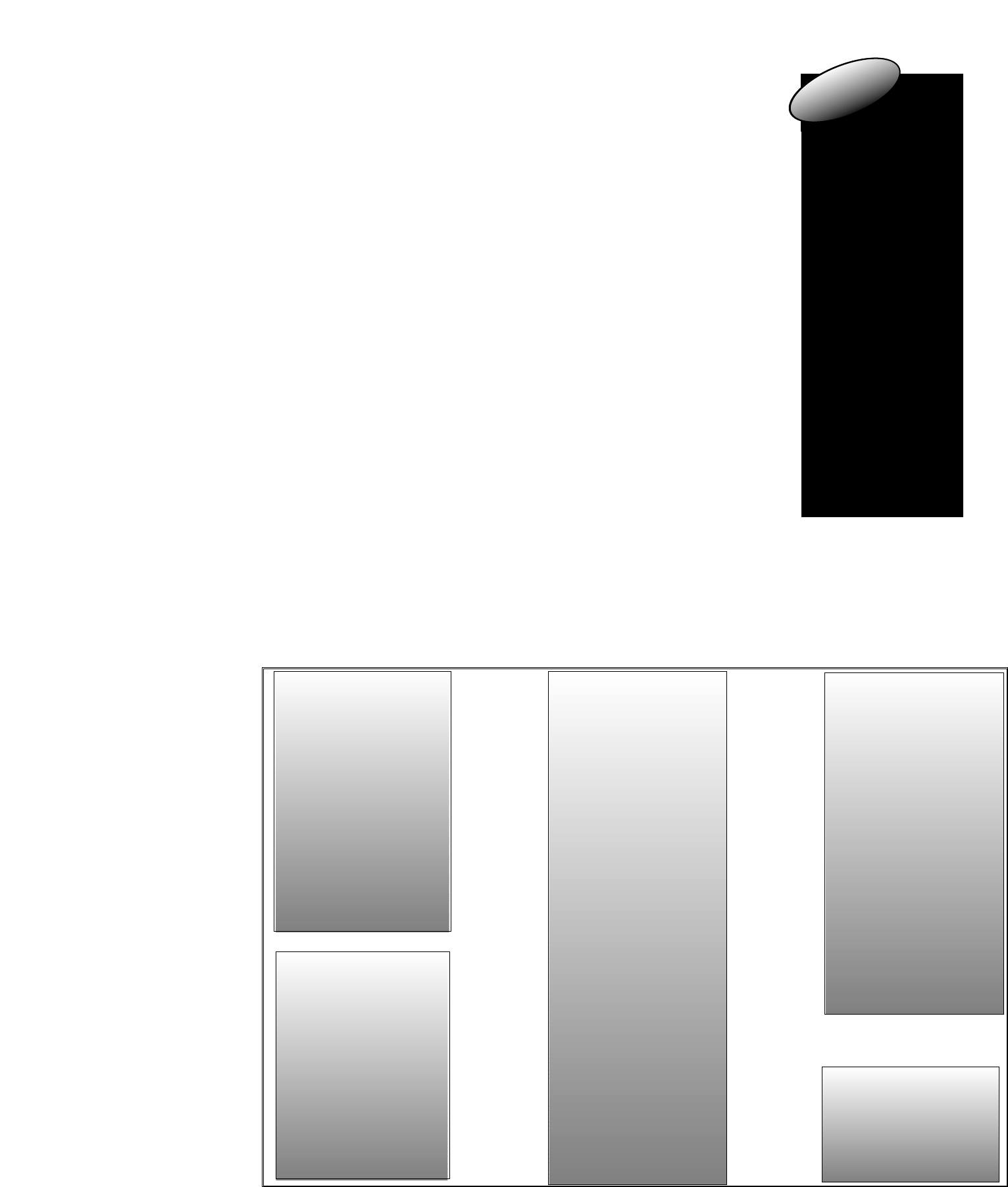
AC-3
Alternate name for Dolby
Digital 6-channel digital audio
standard set by Dolby Labs Inc.
Aspect Ratio
The proportions of a rectangular
display screen. NTSC television
has a 4:3 ratio; HDTV is 16:9.
ATSC
Advanced Television Systems
Committee established by the
Federal Communications
Commission to set standards for
digital television.
Dolby Digital
A digital 6-channel compression
and surround sound audio stan-
dard developed by Dolby Labs
Inc. (also knowN as AC-3.)
DPTV
Digital Projection Televison
comprised of ATSC, NTSC, and
Monitor modules.
DTV
The broadly defined term used
to describe the new digital tele-
vision system adoped by the
Federal Communications
Commission (FCC) in December
1996.
HDTV
Hight Definition Television
which offers approximately
twice the vertical/horizontal res-
olution of NTSC video, and
sound quality approaching that
of compact disc. (Usually taken
to mean a picture of 1920 x
1080 pixels in a 16:9 aspect
ratio.
LED
Light Emitting Diode or indica-
tor.
Major Channel
The RF transmitted channel on
which an ATSC digital station is
broadcast. (Also referred to as
virtual channel.)
MPEG
Motion Picture Experts Group
and the video compression for-
mats they devise for transmis-
sion of digital broadcasts.
NTSC
National Television Standards
Committee format devised for
TV broadcasting signals in the
1940s (525 lines; 30Hz.)
PSIP
Program and System
Information Protocol.
PTV
Projection Television (Rear
and/or Front projection design
sytems are available.)
RC5, RC6
Remote Control definition code
system or protocol.
RF
Radio Frequency or modulated
signal design used as the carrier
for television broadcasts.
RGB
Red, Green, Blue color
SAP
Second Audio Program is a
monoaural soundtrack included
within the a recorded or vidoe
signal (usually containing a sec-
ond language translation for the
displayed programming.)
SDTV
Standard Definition Television is
a digital television transmission,
but with approimately the pic-
ture quality and aspect ration
equivalent to NTSC video.
Subchannel
A complete digital channel num-
ber is composed of both a major
and minor (sub-) channel num-
ber.Located within the “major”
channel’s transmited signal the
“minor” channel can be used and
selected for additional program-
ming.
Subwoofer
a speaker designed for audio
playback of only the lowest-
requency notes (under 100 Hz.)
SVGA
Super Video Graphics Array
VGA
Video Graphics Array
YUV
Yellow, Ultraviolet
P
lease refer to the
rear section of
this Quick-Use guide
(page 8) for additional
information on:
• scheduled Digital
Broadcast program
rollout dates, and
what will be avail-
able from the vari-
ous networks and
program suppliers
• the basics on how
HDTV, Digital, and
Analog TV differ
and how they can
be received
• other Advanced
Television news and
details on product
and system opera-
tions
digital 1nf0rmation
MONITOR FEATURES
• Video Inputs: VGA and HD
• Audio Inputs: stereo and 6-
channel Dolby Digital
• Display formats: normal
(overscan), letterbox, or
underscan
PRONTO REMOTE
• Liquid Crystal Display -
with large backlit touch
screen for direct button entry
and key feature access
• Learn Capability - to learn
and operate other infrared
remote control product codes
• Customize - built-in device
templates for total product
control
• Macro - editable program-
ming for frequently used
button sequences
DIGITALATSC FEATURES
• ATSC Formats - decodes all
ATSC digital system require-
ments as specified by FCC
• ATSC Broadcasts - tunes
terrestrial signal transmissions
of major and sub-channel dig-
ital programming
• PSIP Data - receives and
processes signal data for
Program System Information
Protocol necessary for digital
reception
• Video Display - 1920 x 1080i
resolution capability (4x3
ATSC video formats linearly
stretched to fill 16:9 display)
• DTV Closed Captioning
• Dolby Digital Audio - for
playback of 6-channel Dolby
Digital audio material
• Alternate Audio - plays addi-
tional audio tracks if available
with ATSC programming
• Freeze Video - holds video
action while audio continues
(with time-out feature to pre-
vent possible screen burn)
• Autoprogram - for valid dig-
ital channels (with means of
adding/deleting specific sta-
tions from channel map)
ANALOG NTSC FEATURES
• NTSC - reception of terrestri-
al broadcast NTSC signals
• Audio/Video Inputs - direct
Video, or S-Video input, con-
nections with accompanying
Left/Right 2-channel audio
• TV Guide Plus+ - electronic
program guide
• Parental Control - to censure
undesireable channels from
viewing by children
• Autoprogramming - for easy
automatic selection of favorite
area stations
• Closed Captioning - to view
program dialogue or voice
conversation as on-screen
text.
• Channel Labels - individual
channel call-letter captions
INTEGRATED FEATURES
• 64-Inch Rear Projection
television screen
• Audio Inputs - Stereo and 6-
channel Dolby Digital
• Subwoofer - for low frequen-
cy bass surround sound
• Display formats - normal
(overscan), letterbox, or
underscan
• Clock/Sleep Timer - set in
NTSC analog system opera-
tional in ATSC as well.
• Pronto Remote - set for both
NTSC and ATSC select fea-
ture operations
Digital Television (DTV) - DTV is the coverall term used to
describe the new digital television system adopted by the FCC
in 1996.
High Definition Television (HDTV) - HDTV refers to the
product/system with the following minimum performance specs:
•Resolution: vertical display resolution of 720P, 1080I, or higher
•Aspect Ratio: capable of displaying 16:9 format images at the
minimum resolution levels
•Audio: receives, reproduces, and/or outputs Dolby digital audio
•Receiver: receives all ATSC (Table 3) formats
Standard Definition Television (SDTV) -SDTV refers to the prod-
uct/system with the following performance attributes:
•Resolution: display resolution lower than that of HDTV
•Aspect Ratio: none specified
•Audio: produces useable audio
•Receiver: receives all ATSC (Table 3) formats and produces a
useable picture











